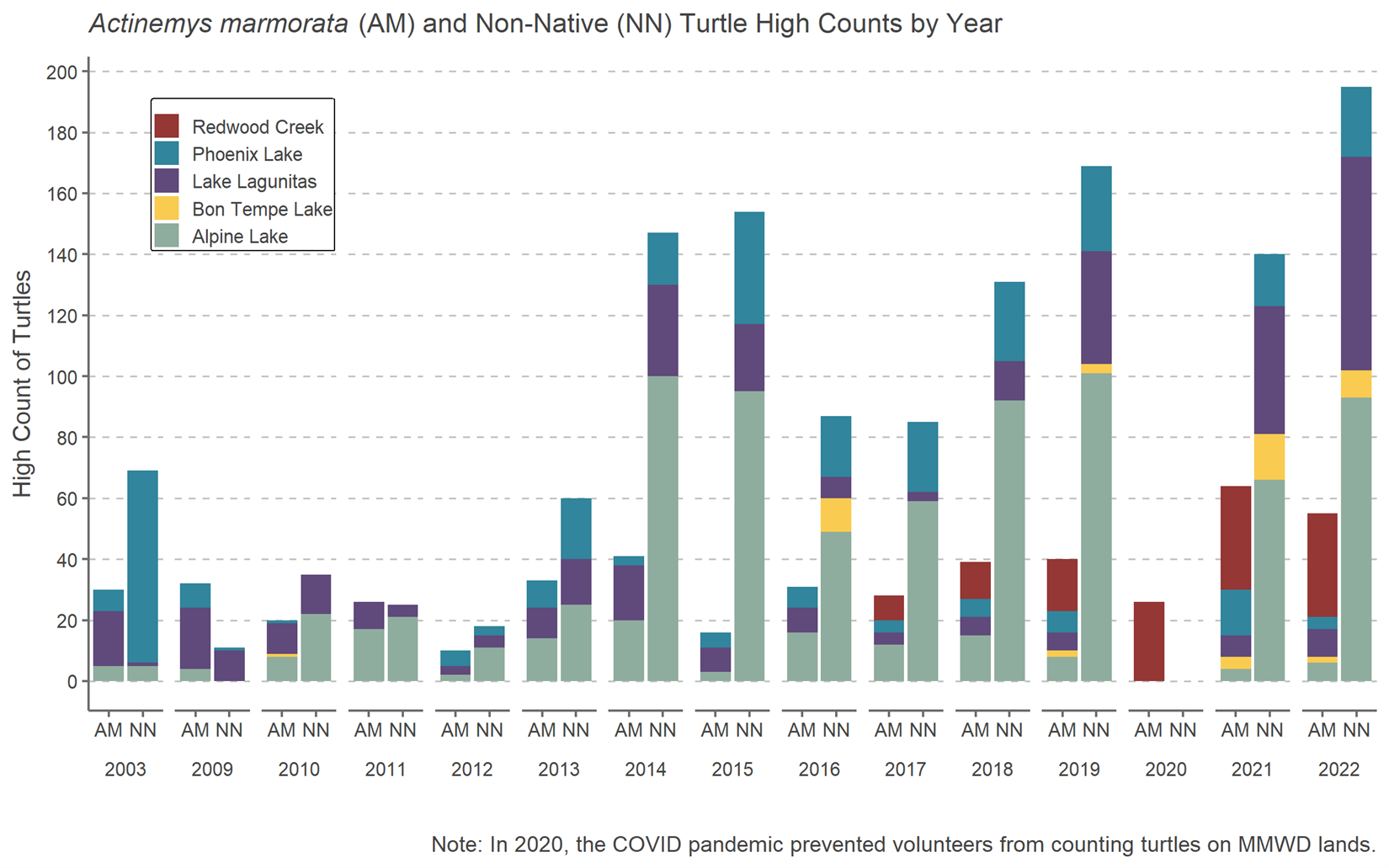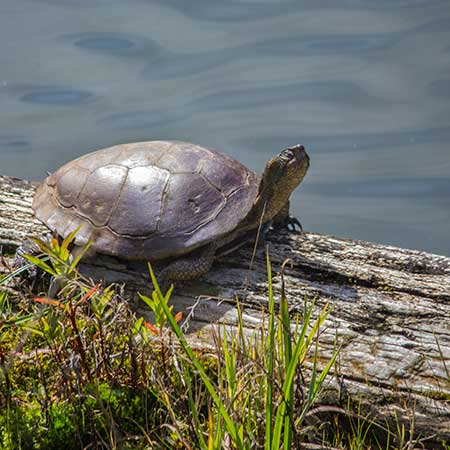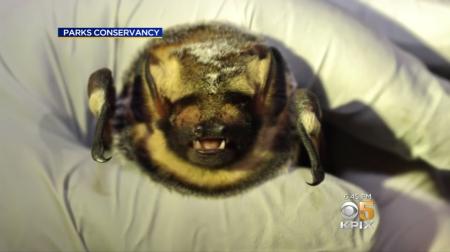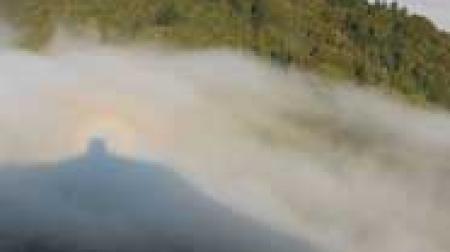Why Was This Indicator Chosen?
The northwestern pond turtle is California’s only native freshwater turtle. This state Species of Special Concern is a good indicator of freshwater aquatic conditions and, to some extent, grassland habitats as well. The small numbers of northwestern pond turtles (Actinemys marmorata) seen at Muir Beach in the early 1990s are gone (PWA, 1994; Ely, 1993; Fong unpublished data, 2015), but years of monitoring on Marin Water lands provides adequate data to understand how the remaining known populations of northwestern pond turtles on Mt. Tam are faring.
What is Healthy?
Northwestern pond turtles should be found in all historically occupied habitats, and the population in the One Tam area of focus should be stable or increasing.
What Are the Biggest Threats?
- Predators like non-native American bullfrogs (Lithobates catesbeianus) and bass (Micropterus spp.), as well as certain overly abundant native predators such as skunks (Spilogale spp.), raccoons (Procyon lotor), ravens (Corvus corax), and crows (Corvus brachyrhynchos)
- Competition or predation from red-eared sliders (Trachemys scripta elegans) and other non-native turtles that live in Mt. Tam’s ponds and reservoirs; non-native turtles released into waters may also introduce disease
- Car strikes as the turtles travel between aquatic habitats or when migrating to nesting sites
- Temperature increases and/or changes in precipitation patterns as a result of climate change could affect the streams and small ponds upon which this species depends
What is The Current Condition?
The overall condition is Fair. In 2022, northwestern pond turtles continue to occupy the four Marin Water reservoirs they occupied in 2016. They now inhabit Redwood Creek as well, thanks to the head start program where, in collaboration with the San Francisco Zoo and Sonoma State University, the National Park Service reintroduced 42 northwestern pond turtles to Redwood Creek between 2017 and 2021. However, the population is still small and faces numerous stressors. The current condition of caution reflects the relatively recent occupancy at Muir Beach and that these turtles have yet to demonstrate successful reproduction and recruitment.
In 2021, volunteer Turtle Observers counted 30 northwestern pond turtles in Marin Water’s reservoirs. While this was the same number as was counted in 2003, the three-year average was only 27 turtles, which could be a cause for some concern. As of summer 2021, the National Park Service monitors had counted 34 juveniles (of the 42 introduced since 2017) in the Redwood Creek Watershed, bringing the latest number in the One Tam area of focus to nearly double the 2016 baseline estimate.
What is the Current Trend?
The trends is Improving: the expansion of the population into Redwood Creek is cause for cautious optimism.
How Sure Are We?
Our confidence is High, as multiple data sources support habitat occupancy assessments, and ongoing monitoring has yielded consistent results regardless of the level of effort.
What is This Assessment Based On?
- Marin Water habitat survey in 2003
- Marin Water monitoring since 2004, including mark and release efforts (2004-2016) and the Turtle Observer volunteer program since 2009
- National Park Service inventory data from the One Tam area of focus from 1996 (Fong, 2002) and 2014–2015
What Don’t We Know?
Key information gaps include:
- Population drivers such as egg and hatchling predation rates that affect abundance, survival, and recruitment; the cause of the decline and loss of western pond turtles from Muir Beach; and the influence of local coastal climatic conditions on breeding ecology
- Demographic data on age/size structure of sustainable western pond turtle populations in coastal California
- Surveys including presence/absence data for historic populations
- Ulcerative shell disease has been detected in Santa Cruz but as of this update it is uncertain whether turtles in the One Tam area of focus are affected
resources
Bury, R. B., Welsh, H. H., Jr., Germano, D. J., & Ashton, D. T. (2012). Objectives, nomenclature and taxonomy, description, status, and needs for sampling. In R. B. Bury, H. H. Welsh, Jr., D. J. Germano, & D. T. Ashton (Eds.), Western pond turtle: Biology, sampling techniques, inventory and monitoring, conservation, and management: Northwest Fauna 7 (pp. 1–7). Society for Northwestern Vertebrate Biology. https://www.csub.edu/~dgermano/WPTHandbook-Chpt1.pdf
Ely, E. (1993). Sensitive species herpetological survey, Golden Gate National Recreation Area, 1993. Prepared for Golden Gate National Park Association.
Ettlinger, E. (2016). Monitoring turtles on the Mount Tamalpais Watershed, 2015. Marin Municipal Water District.
Fong, D. (2002). Western pond turtle inventory, Golden Gate National Recreation Area. Golden Gate National Recreation Area. [Unpublished].
Garcia and Associates [GANDA]. (2003). Mt. Tamalpais Watershed western pond turtle study. Prepared for Marin Municipal Water District.
Museum of Vertebrate Zoology. (1999). Specimen collected in 1936 from Phoenix Lake [Collections database]. Retrieved from http://arctos.database.museum/guid/MVZ:Herp:64486
National Park Service (2015). Western pond turtle monitoring program [Unpublished data].
National Park Service (2016). Western pond turtle monitoring program [Unpublished data].
Philip Williams and Associates [PWA], Moss Landing Marine Laboratory, Smith, J., Northmore, J., Roberts and Associates, & Horner, N. (1994). Preliminary environmental assessment of wetland restoration alternatives for Big Lagoon at Muir Beach, Marin County. Prepared for California Department of Transportation, District IV.
Pierce, D. W., Kalansky, J. F., & Cayan, D. R. (2018). Climate, drought, and sea level rise scenarios for California’s fourth climate change assessment (Publication no. CCCA4-CEC-2018-006). Prepared for California Energy Commission. https://tinyurl.com/4hu6r6uh
Prado, Mark. (2011, June 7). Marin turtle’s trek has biologists amazed. Marin Independent Journal. https://tinyurl.com/yc63wfkd
Shaffer, B. (2019). Assessment for the western pond turtle: Final report. Prepared for U.S. Fish and Wildlife Service. https://tinyurl.com/22kypyj6
Sherman, J., Howe, A., & Ettlinger, E. (2021). Turtle observer report. Marin Water.
van Dijk, P. P., Iverson, J. B., Rhodin, A. J. G., Shaffer, H. B., & Bour, R. (2014). Turtles of the world, 7th ed.: Annotated checklist of taxonomy, synonymy, distribution with maps, and conservation status. Chelonian Research Monographs, 5(7), 329-479. https://tinyurl.com/4259wr




